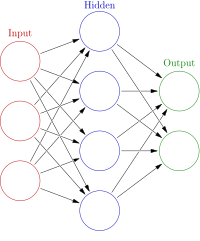
Photo from wikipedia
The inverse protein folding problem, also known as protein sequence design, seeks to predict an amino acid sequence that folds into a specific structure and performs a specific function. Recent… Click to show full abstract
The inverse protein folding problem, also known as protein sequence design, seeks to predict an amino acid sequence that folds into a specific structure and performs a specific function. Recent advancements in machine learning techniques have been successful in generating functional sequences, outperforming previous energy function-based methods. However, these machine learning methods are limited in their interoperability and robustness, especially when designing proteins that must function under non-ambient conditions, such as high temperature, extreme pH, or in various ionic solvents. To address this issue, we propose a new Physics-Informed Neural Networks (PINNs)-based protein sequence design approach. Our approach combines all-atom molecular dynamics simulations, a PINNs MD surrogate model, and a relaxation of binary programming to solve the protein design task while optimizing both energy and the structural stability of proteins. We demonstrate the effectiveness of our design framework in designing proteins that can function under non-ambient conditions.
Journal Title: Biomolecules
Year Published: 2023
Link to full text (if available)
Share on Social Media: Sign Up to like & get
recommendations!